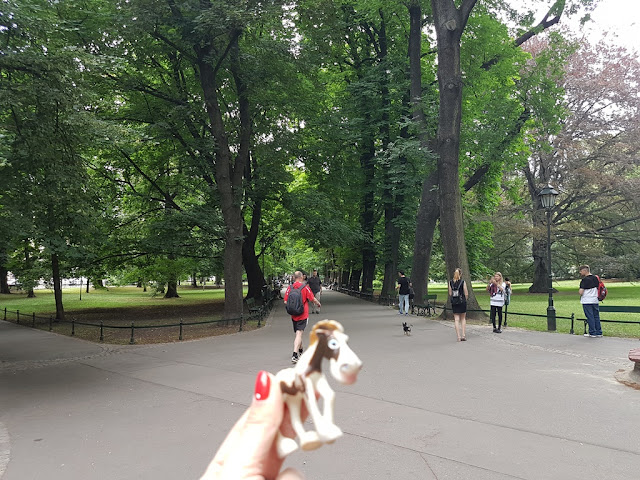Last time that we were in Kraków, we managed to visit the Old Town and the Royal Castle on the Wawel Hill. But the weather was not inviting and we could not admire one of the most enjoyable places there - the Planty park.
The peculiarity of Planty is that the park is actually round shaped and runs around the entire Old Town.
As you probably guessed, it was created in the nineteenth century when the rulers of the city decided that the old and falling walls, together with the accompanying moat, are no longer needed. Our walk today will start next to the Barbican.
Let's move into the green.
As we pass, you can see a small fountain.
It is located in the middle of an artificial lake.
The lawns are embellished with flowery carpets and monuments. The one in the back is commemorating Artur Grottger, a famous Polish painter.
And that one is for Lilla Weneda, a fictious character from a drama by one of the most famous Polish poets - Juliusz Słowacki.
And here comes another one, this time from a poem by probably the most famous Polish poet - Adam Mickiewicz. Her name is Grażyna (actually Mickiewicz invented this name himself but it is quite popular now in Poland).
As we move along, we can see several buildings of great importance to the city. Like the seat of the Kraków Society of Friends of Fine Arts.
Then comes the Collegium Novum so the new college of the Kraków University.
As you rightly guessed, if there is a new college, there must be an old one as well. But it is not called old but great - Collegium Maius.
It is the Jagiellonian University's oldest building, dating back to the 14th century. Today it is no longer belonging to students but was turned into a museum.
Just next to Collegium Maius you will find the Professor's garden.
Inside, you can realise what professors looked like when Mikołaj Kopernik was one of the students in Kraków.
I admit that I like this porch a lot.
Next to the University buildings, you can see a few remainings of the old walls.
I was walking on Planty with an American friend and he said it looks a lot like Central Park in New York. I have never been there so I cannot judge - any opinions?
Finally, we arrive to the other side of the Old Town, having made half of the length of Planty. Up there, you can already spot the Wawel castle.
But I propose we do not walk up the hill but instead take this nice lane and walk back to the Market Square.
Here, those of you who are too tired to walk can continue in one of those nice carriages. I will stay there and have a chat with my cousins.
The peculiarity of Planty is that the park is actually round shaped and runs around the entire Old Town.
As you probably guessed, it was created in the nineteenth century when the rulers of the city decided that the old and falling walls, together with the accompanying moat, are no longer needed. Our walk today will start next to the Barbican.
Let's move into the green.
As we pass, you can see a small fountain.
It is located in the middle of an artificial lake.
The lawns are embellished with flowery carpets and monuments. The one in the back is commemorating Artur Grottger, a famous Polish painter.
And that one is for Lilla Weneda, a fictious character from a drama by one of the most famous Polish poets - Juliusz Słowacki.
And here comes another one, this time from a poem by probably the most famous Polish poet - Adam Mickiewicz. Her name is Grażyna (actually Mickiewicz invented this name himself but it is quite popular now in Poland).
As we move along, we can see several buildings of great importance to the city. Like the seat of the Kraków Society of Friends of Fine Arts.
Then comes the Collegium Novum so the new college of the Kraków University.
As you rightly guessed, if there is a new college, there must be an old one as well. But it is not called old but great - Collegium Maius.
It is the Jagiellonian University's oldest building, dating back to the 14th century. Today it is no longer belonging to students but was turned into a museum.
Just next to Collegium Maius you will find the Professor's garden.
Inside, you can realise what professors looked like when Mikołaj Kopernik was one of the students in Kraków.
I admit that I like this porch a lot.
Next to the University buildings, you can see a few remainings of the old walls.
I was walking on Planty with an American friend and he said it looks a lot like Central Park in New York. I have never been there so I cannot judge - any opinions?
Finally, we arrive to the other side of the Old Town, having made half of the length of Planty. Up there, you can already spot the Wawel castle.
But I propose we do not walk up the hill but instead take this nice lane and walk back to the Market Square.
Here, those of you who are too tired to walk can continue in one of those nice carriages. I will stay there and have a chat with my cousins.


















































